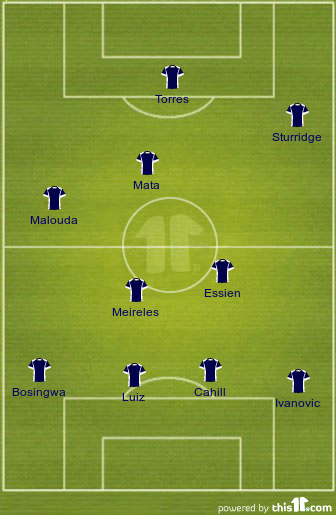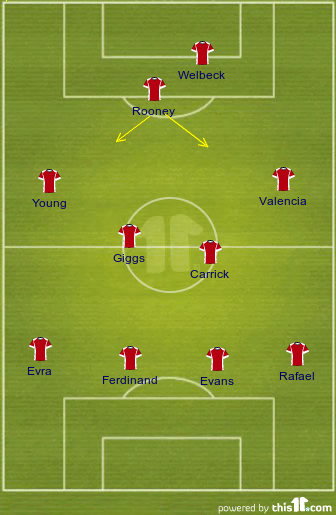Not so many years ago, this fixture would’ve had the country enraptured – streets would’ve been deserted, cars abandoned with their engines idling, their owners pressed up against TV rental showroom windows, babes left crying in their cots, dogs left scratching at the back door wanting to be let out – everything had to wait. But the days of Chelsea being title contenders have gone, for now at least, and Chelsea’s home record is not what it was. Chelsea are not in the two horse race for the title, they are six points behind Tottenham who play tomorrow, and they went into this game twelve points behind their former sparring partners. Perhaps only Arsenal’s patchy season is saving Chelsea from more derision than they are getting – the thoughts are though, that this is a team in transition which will come good again.

Chelsea and Manchester United are both sides who have had injury problems of late. Manchester United could put out a fairly decent side made up of all of the absent players. Lindegaard in goal, Smalling, Phil Jones, Vidic and De Laet make up a serviceable back four, across the midfield you could have Nani, Cleverley, Anderson and *cough* Bebe *cough*, with old Mickey Owen running around quite slowly not winning headers up front. Seriously though, six of those eleven would’ve been considered for the starting eleven had they been fit. Chelsea are not quite as crippled as United, but were still missing the spine of their team. Terry, Lampard out injured, along with Ramires and Mikel - and Drogba still away at the Africa Cup of Nations.
Chelsea lined up in a now familiar 4-3-3, but with a few subtle tweaks. Villas-Boas has shown some compromise in his footballing beliefs, but is still a man who trusts his philosophy of pressing all over the pitch and a high back line. The compromises came in the positioning of the two wingers Sturridge and Mata. Mata in truth played more centrally, allowing Malouda to push up the left wing, although there was interchange between the two. Malouda had ostensibly been included as one of the midfield three along with Meireles and Essien. It could be described as a 4-2-3-1, with Torres ploughing the lonely furrow on his own, but Sturridge’s attacking instincts had him in a striking position, while Torres often drifted wide to the right.

John Terry has looked to be one of those Chelsea players who struggle with the new system, and whether the acquisition of Gary Cahill from Bolton was a short-term measure with an eye on court proceedings (Now a mute-point as Terry’s court date has been set for after the season has finished) or whether he’s been brought in to provide a long-term replacement for Terry, Cahill’s style should suit that high line better than Terry. He’s more mobile and quick-witted too, he’ll suit the style – whether he has the quality to help turn Chelsea back into contenders is still in question.
There were no surprises in the back five – although any line up with David Luiz included has the potential for surprises at any stage. Ashley Cole missed the game through suspension, so Bosingwa filled in on the left. Manchester United fans will have been licking their lips in anticipation of an in-form Valencia up against Bosingwa playing on his less favoured side.
How did Manchester United line up? Well… was it a 4-2-3-1 with Giggs and Carrick as a double-pivot behind the trio of Valencia, Rooney and Young in support of Welbeck? Or was it a 4-4-2, or a 4-4-1-1. Rooney is the x-factor here. He prowls the field of play almost in a free role, confusing opposition markers and confounding pundits by popping up all over the place. The concern for United fans won’t be at which string of numbers best represent the formation, but at the names at the heart of the defence. Ferdinand is not having a good season. He’s not got the get-out-of-jail pace he used to have, and Johnny Evans will have to produce a large number of outstanding displays before he will ever be trusted as a first choice centre-back for United. Let’s call it a 4-4-2 for Sir Alex’s sake.

The first half was in a way reminiscent of a Mourinho era Chelsea. Functional, disciplined, and effective. They were perhaps fortunate not to concede one penalty, and also perhaps fortunate not to have Gary Cahill sent off for felling Welbeck just outside the box with no other defender looking in a position to trouble the attacker. As it was both decisions were called no fouls, much to the annoyance of the men in red. These things have a way of evening up over as season, but rarely do they do so over the course of the same game.
Although, as mentioned above it looked on paper that the most easily won duel between player could have been Bosingwa up against Valencia, it was on the other flank and in the favour of the other team that the mismatch actually presented itself. Captain Patrice Evra was given a torrid time during the opening half, and for large periods of the second. Evra isn’t one of those modern attacking fullbacks who can’t defend – he’s a good defensive player who is also adept at overlapping on the attack, but he was out of sorts for much of this match. Two of Chelsea’s goals came about because Evra couldn’t deal with Sturridge. Capello take note!
First, Evra allowed Sturridge to skip past him and cut a ball back across from the byline, which ricocheted off De Gea and Evans into the net. Perhaps that should read “the hapless De Gea and the hapless Evans”. The third goal – not entirely Evra’s fault – but his foul on Sturridge, bringing the Chelsea player down as he went by again, gave Chelsea the free-kick from which Mata set up David Luiz to head home. The David Luiz surprise element in this story is that he was almost completely unmarked, Ferdinand trying to look stern after the event when everyone knew that sheepish would have been more apt. Between Manchester United’s calamitous concessions was the pick of the goals, what was missing from forty five minutes of the first half came to fruition just forty seconds into the second – a moment of genuine quality - Torres showing his team mates how to assist a goal with a wonderful cross to Mata who slammed a thundering volley home with his left.
When the third went in, Sir Alex Ferguson had to act. The ineffective (some would say woeful) Ashley Young was replaced by Javier Hernandez who went up top alongside Welbeck, with Rooney pulling the strings just behind. This gave Evra the impetus to drive forward more. Sturridge had inflicted real damage on the United left-back, and it was his turn to be on the back foot. An Evra run into the box highlighted the fact that Sturridge is a striker, converted to a winger, asked to contribute defensively – it was a clumsy tackle in the box.
Rooney duly equalised form the spot, and the comeback was on. Not many teams would even consider fighting back from 3-0 down at Stamford Bridge, let alone be able to – but a team like Manchester United wouldn’t consider not fighting back. Ferguson appraised his bench and sent on another attacking substitution. Paul Scholes came on for Rafael, Valencia switched to right-back as he has many times now, and Giggs was shuffled out to the left. The old master proved his worth yet again with the cross for United’s equaliser. At the time of the tactical switch, a comeback had seemed improbable.

Clumsy defending might have been to blame for two of Chelsea’s shipped goals, but the tactical changes made by Ferguson forced pressure on Chelsea, who really didn’t have an answer. Chelsea had found themselves 3-0 without really playing that well – Mata’s goal aside – and in the end might be considered lucky to get a point which is a ridiculous situation to find themselves in after leading by three clear goals. The instructions given to Villas-Boas' men are to press and look for interceptions all over the pitch. Once the comeback had begun, his players just didn't perfrom this as well as they had in the first half, which barring two penalty claims, was a pretty barren period of football for Manchester United.
Chelsea's interceptions where down from 19 in the first half to just 8 in the second. Ferguson removed ineffective players, shuffled players of influence into more dangerous positions, and clawed back a three goal deficit.














